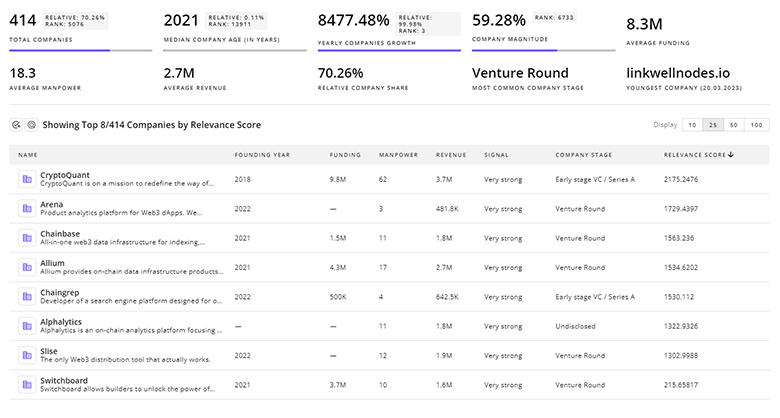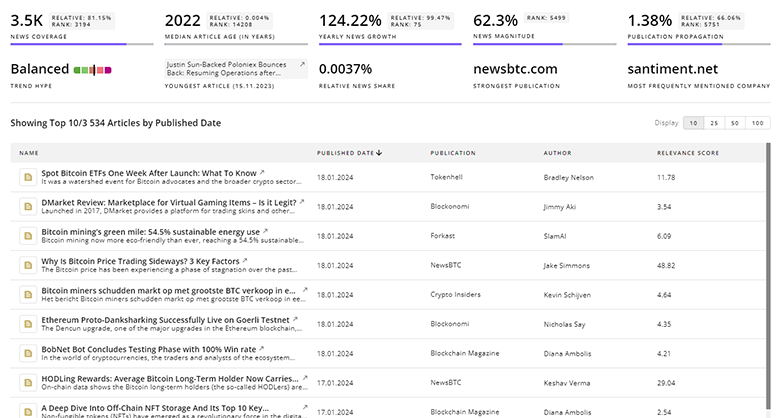Health Tracking Report
: Analysis on the Market, Trends, and TechnologiesThe health-tracking market has entered a fast-scale growth phase: the internal trend data reports a 2024 market size of $70,050,000,000 and a 20.1% CAGR projection, driven by broader adoption of multi-parameter wearables and platform consolidation. Consumer activity tracking (steps, calories, workouts) remains the single largest use case in major markets (35% of U.S. mobile users report tracking exercise) statista – 2024. Hardware trends favor low-cost optical sensors (PPG) while analytics and remote patient monitoring convert continuous streams into actionable clinical and wellness interventions towardshealthcare.com Firstup.
We updated this report 48 days ago. Missing information? Contact us to add your insights.
Topic Dominance Index of Health Tracking
The Topic Dominance Index combines the distribution of news articles that mention Health Tracking, the timeline of newly founded companies working within this sector, and the share of voice within the global search data
Key Activities and Applications
- Continuous vital-sign capture for personal and clinical use (heart rate, SpO2, temperature, respiratory rate). This remains a core application as device accuracy and sensor suites improve.
- Remote patient monitoring (RPM) that streams wearable and home-device metrics into clinician workflows to reduce readmissions and accelerate decision making.
- Sleep analytics and "performance" style sleep scoring that convert nocturnal metrics into recovery and training guidance for athletes and health-conscious consumers.
- Nutrition and diet logging that pair image/voice/ barcode capture with AI nutrient estimation to close the intake-to-outcome loop for weight and metabolic care.
- Condition-specific monitoring (continuous glucose sensing, AFib screening, blood-pressure trending) aimed at chronic disease management and clinical integration.
- Behavioral coaching and habit formation (AI coaching, gamified challenges) that raise long-term adherence and translate tracking into measurable lifestyle change.
Emergent Trends and Core Insights
- AI-first signal processing: device vendors and platforms move workload into ML models to convert noisy sensor streams into individualized risk scores and short-term alerts; this is now a commercial expectation rather than an optional feature.
- Platform consolidation and data aggregation: single-feature products face margin pressure as users and enterprises prefer integrated platforms that ingest wearables, apps, and clinical records.
- Niche verticals with outsized growth: women's and intimate-health trackers, sleep performance products, and mental-health monitoring show double-digit volume expansion and higher monetization potential than general step counters.
- Asia-Pacific growth pull: faster market adoption driven by aging populations and rising chronic-disease burden positions APAC as a primary scaling region for devices and RPM services.
- Privacy and data-sovereignty as product features: transparent ownership, selective sharing, and device-level preprocessing (edge AI) now act as purchase drivers for privacy-sensitive consumers and enterprise buyers.
- Passive capture and reduced friction: passive sensing (insoles, rings, contactless radar, sweat biosensors) proves that lowering user burden materially increases engagement and data completeness.
Technologies and Methodologies
- Photoplethysmography (PPG) and improved PPG algorithms for continuous heart-rate, SpO2 and HRV monitoring — cost efficient and dominant across consumer devices.
- Multi-sensor fusion (PPG + ECG + accelerometer + temperature + bioimpedance) to improve accuracy and enable condition detection beyond single-metric limits.
- Edge AI and on-device preprocessing to reduce latency, conserve bandwidth, and preserve privacy while delivering near-real-time alerts.
- Non-invasive biochemical sensing (sweat, breath, optical spectroscopy) for metabolic and glucose proxies; still in early clinical validation but high commercial interest olive.earth.
- Computer vision and image recognition for automated meal logging and macronutrient estimation to lower manual entry costs in nutrition tracking.
- Cloud platforms and APIs for interoperability with major health ecosystems (Apple Health, Google Fit) and EHRs to enable clinical workflows and third-party integrations.
Health Tracking Funding
A total of 316 Health Tracking companies have received funding.
Overall, Health Tracking companies have raised $4.2B.
Companies within the Health Tracking domain have secured capital from 1.3K funding rounds.
The chart shows the funding trendline of Health Tracking companies over the last 5 years
Health Tracking Companies
- Inviza — Inviza develops AI-enabled smart insoles and wearable platforms focused on continuous gait and pressure monitoring for rehabilitation and fall risk detection. The company emphasizes long battery life and self-recharging mechanisms in its hardware and has showcased commercial pilots at international health conferences.
- ATLASense Biomed — ATLASense builds predictive analytics and early-screening toolchains that combine wearable streams with clinical markers for sepsis and cardiovascular risk; the firm recently secured public grants for predictive model development and clinical validation.
- ViBo Health — ViBo Health pursues non-invasive metabolic monitoring including wearable spectroscopy and point-of-care platforms aimed at metabolic disease management; the company has announced strategic investments and competition wins that accelerated product pilots.
- Calorik — Calorik couples computer-vision meal recognition with AI nutrient estimation and diet coaching workflows for consumers and B2B wellness programs; their approach targets the high friction point in diet logging by automating intake capture.
- TricorderZero — TricorderZero builds multi-sensor wearable arrays and developer toolkits for advanced biometric capture (ECG, bioimpedance, environmental sensors) aimed at research and niche clinical trials; they position as an integration partner for specialized monitoring projects.
Gain a competitive edge with access to 1.7K Health Tracking companies.

1.7K Health Tracking Companies
Discover Health Tracking Companies, their Funding, Manpower, Revenues, Stages, and much more
Health Tracking Investors
Leverage TrendFeedr’s sophisticated investment intelligence into 1.3K Health Tracking investors. It covers funding rounds, investor activity, and key financial metrics in Health Tracking. investors tool is ideal for business strategists and investment experts as it offers crucial insights needed to seize investment opportunities.

1.3K Health Tracking Investors
Discover Health Tracking Investors, Funding Rounds, Invested Amounts, and Funding Growth
Health Tracking News
TrendFeedr’s News feature provides a historical overview and current momentum of Health Tracking by analyzing 3.8K news articles. This tool allows market analysts and strategists to align with latest market developments.

3.8K Health Tracking News Articles
Discover Latest Health Tracking Articles, News Magnitude, Publication Propagation, Yearly Growth, and Strongest Publications
Executive Summary
Health tracking now sits at the intersection of reliable sensor hardware, scalable analytics, and clinical workflow integration. The market economics (large 2024 base and double-digit CAGR) favor platform plays that convert raw sensor telemetry into short-term alerts and long-term behavior change. Winners will prove three capabilities in parallel: accurate multi-modal sensing, clinically relevant predictive models, and transparent data governance that customers and providers trust. Niche specializations (women's health, metabolic monitoring, sleep performance) represent high-margin entry points for smaller players, provided they embed interoperability with larger health platforms and offer measurable outcomes that clinicians accept.
Interested in contributing your expertise on trends and tech? We’d love to hear from you.












